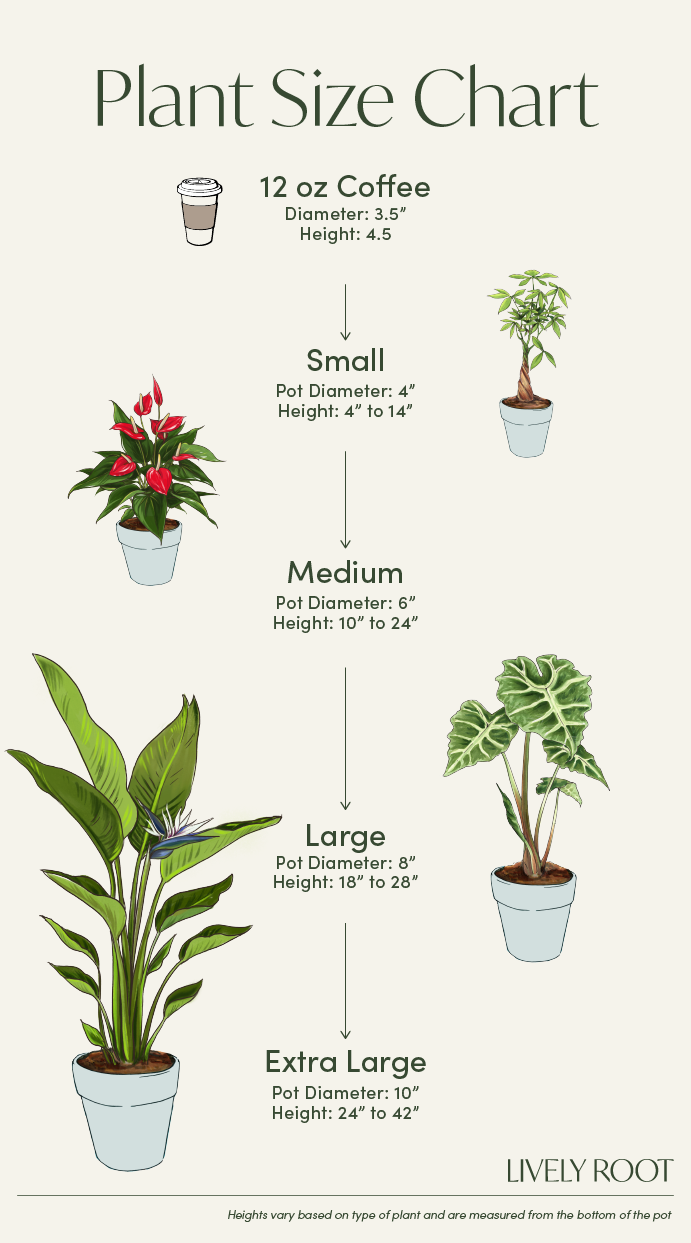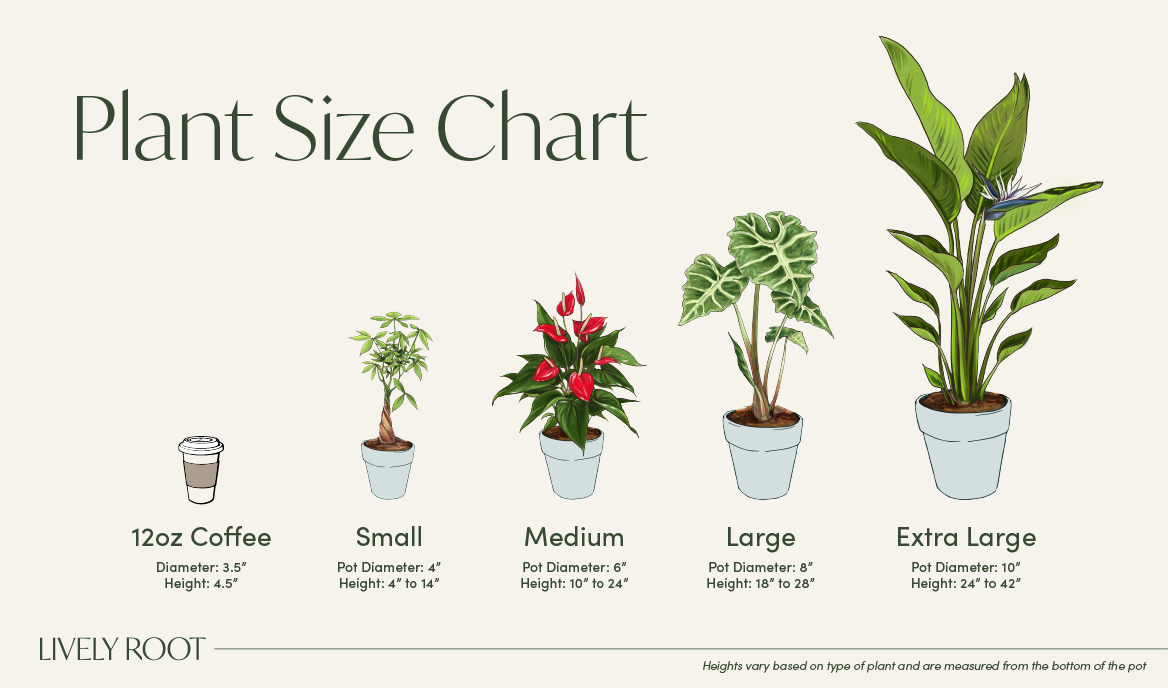

Enhance your space with the Ruby Rubber Tree (Ficus elastica 'Ruby'), a versatile indoor tree perfect for beginners and experienced plant lovers. Known for its ease of care, this rubber tree plant can grow up to 8 feet indoors, making it a prime choice for those seeking a large, full-grown floor plant. The Ruby Rubber Tree is not just an attractive indoor tree; it also purifies the air, making it both a stylish and functional addition to any home or office.
Ruby Ficus Elastica Care Guide & Presentation

Best in medium light, but can survive in a range of low to high.
Allow the soil to dry out completely between waterings.
Prefers humidity. Spritz occasionally.
Outside: Keep in shade on a patio where nights are above 60°F.
Apply a balanced, liquid fertilizer especially formulated for indoor plants every month during the growing season.
When receiving the Variegated Rubber Tree plant, do not repot immediately but wait at least 6-12 months.
Repot in the spring, using a 2 inches bigger pot.
Place a piece of screening at the bottom of the container over the drainage hole to secure the soil and allow to drain. Use a well-draining potting mix half and half with a cacti and succulent potting mix to help with drainage.
Water your plant in the old pot before transferring over and let sit an hour.
Add the soil mix to the bottom to elevate the root ball. Lift the plant and release the roots against the existing planter. Use a clean knife or garden trowel to wedge between the pot and the soil to loosen.
Inspect the root ball. Notice if there are any dead or rotting roots and trim off with sterile pruners. If the plant is rootbound, loosen the roots to alleviate continued encircling.
Ensure the plant is sitting about 1 inch below the edge of the pot to avoid water spillage. Add more soil and backfill around the sides by tamping down. Fill up to the soil line but not over.
Water thoroughly, leaving the soil damp but not soggy. If settling occurs, add more soil.
Water well to dampen the soil and let drain.
To prune these Rubber Tree plants, wear gloves to avoid skin irritation and use sharp, sterilized pruners. The best time to prune is in late spring or early summer. Cut right above the node (where leaves are attached to the stem), causing branching to occur for a bushier plant. Don't remove more than one-third of the plant's foliage to keep them healthy.
Take a stem cutting with sanitized pruners, 6-8 inches long with leaves attached. Trim off the bottom leaves on the stem.
Dip the stem in water, then rooting hormone. Stick the stem into the soil mix.
Use a pot with drainage and place the stem 1-2 inches down into the damp, well-draining, moist mixture of cacti and succulent soil and regular potting mix with perlite in equal parts.
Tamp down around the stem to secure. Place a clear plastic bag over the cutting to mimic a greenhouse and mist the bag.
Set in bright, indirect sunlight while they are rooting. Check the moisture and humidity each day and add misting to keep the soil moist while the roots establish.
After 6-8 weeks, roots will begin to establish. You can tug onto the stem to ensure the roots are secure. Remove the plastic bag but maintain adequate humidity around the new plant.
Ruby Ficus: Overview
The Ruby Rubber Plant, scientifically known as Ficus robusta “Ruby”, is a stunning addition to any indoor space. Belonging to the family Moraceae, this popular indoor plant is native to Southeast Asia. With its vibrant ruby-colored leaves, it adds a pop of color to your home decor. Ideal for hardy plant zones 10-12, it thrives in warm, humid conditions. Known for its longevity and large size, it can grow up to several feet tall indoors.
While it enjoys bright, indirect sunlight, it can tolerate lower light conditions, making it suitable for various environments. As with other rubber plants, it’s relatively easy to care for and can make a striking statement piece in your home.
The Ficus Ruby Rubber plant symbolizes abundance, prosperity, and growth. Its lush foliage and vibrant color bring a sense of vitality, making it an excellent addition to spaces where you seek to promote positivity and well-being.
While ficus plants are a beautiful and beneficial addition to your indoor space, it’s important to note that they are toxic to pets if ingested. Keep it out of reach of curious pets to ensure their safety.
Check out other rubber plant varieties like Ficus Elastica - “Burgundy” Rubber Tree or Ficus Elastica Tineke, available on Lively Root if you’d like a diverse selection.
Ruby Ficus: Benefits
- Enhances indoor air quality by purifying the air
- Increases humidity levels, benefiting both plants and humans
- Symbolized good fortune and prosperity
- Adds aesthetic appeal to indoor and outdoor spaces
Ruby Ficus Elastica: Care Guide
Ruby Ficus Elastica, commonly known as the Ruby Rubber Plant, is a relatively low-maintenance plant, suitable for beginners and experienced plant enthusiasts alike.
Watering and Light Requirements
Ensure the soil remains consistently moist but not soggy, allowing the top inch to dry out between waterings. Place in bright, indirect light, avoiding direct sunlight that can scorch its leaves.
Temperature and Humidity
Keep your Ruby Rubber tree plant in a warm environment with temperatures between 65°F to 80°F (18°C to 27°C). It thrives in moderate to high humidity therefore, occasional misting will benefit your plant.
Soil, Repotting, and Feeding
Plant your Ruby Rubber tree in well-draining soil, such as a mixture of potting soil and perlite. Repot every 2-3 years or when the roots outgrow the pot. Feed monthly during the growing season with a balanced liquid fertilizer.
Propagation
Propagate your Ruby Rubber plant by using healthy stem cuttings. Dip them in rooting hormone and plant them in small pots with fresh soil. Keep the new plants in a spot with bright, indirect light. Roots should develop within 6-8 weeks. Newly propagated Ruby rubber plants will make the perfect gift that attracts abundance and happiness.
Pruning and Maintenance
Regularly prune to maintain its desired shape and remove any yellowing or damaged leaves. Wipe leaves gently with a damp cloth to remove dust, allowing the plant to breathe freely. Watch for signs of pests like spider mites and treat them promptly if detected.
Ruby Ficus: Placement, Companion & Alternative Plants
When considering the placement of your Ficus Elastica Ruby’s placement, finding the right spot to showcase its vibrant foliage and enhance your space is essential. Additionally, selecting suitable companion plants can complement its aesthetic and care requirements, creating a harmonious indoor greenery ensemble.
Best Locations & Uses
- Ideal for plant enthusiasts seeking a low-maintenance yet visually striking addition to their indoor jungle.
- It is perfect for individuals with a spacious living area or office, as its sizable presence can fill larger spaces with lush greenery.
- It is well-suited for those residing in warmer climates, where it can thrive indoors and outdoors, adding a touch of tropical charm to gardens and patios.
- It is a fantastic choice for beginner gardeners looking to cultivate their green thumb, as it tolerates a wide range of conditions with minimal fuss.
- Thanks to its richly colored leaves and statuesque growth habit, this plant is excellent for individuals seeking to create a bold focal point in their interior decor.
Companion Plants
Enhance your Ruby Ficus plant with complementary greenery.
- Pothos Pearl Jade (Epipremnum aureum “Marble Queen”): The Pothos Pearl Jade is a versatile vine that not only thrives in similar light and moisture conditions but also adds cascading foliage to complement the upright growth of your rubber plant.
- Peace Lily (Spathiphyllum): With its elegant white blooms and preference for low to moderate light, the Peace Lily makes an ideal companion, creating a harmonious contrast in texture and form.
- Snake Plant (Sansevieria trifasciata “Superba”): Known for its resilience and air-purifying qualities, the Snake Plant pairs perfectly with the Ruby Rubber plant,
Alternative Plants
Explore pet-friendly alternatives to the Ruby Rubber Plant:
- Neanthe Bella Palm (Chamaedorea elegans): With its graceful fronds and compact size, the Neanthe Bella Palm is an excellent choice for pet owners seeking a non-toxic option that adds a touch of greenery to any space.
- Boston Fern (Nephrolepis exaltata): Renowned for its air-purifying properties and lush foliage, the Boston Fern is a safe and stylish fern variety - a great alternative to the rubber plant, providing a vibrant and pet-friendly accent to your home.
- Spider Plant (Chlorophytum comosum): Featuring arching leaves and an easy-care nature, the Spider Plant is a resilient choice that adds texture and visual interest while remaining safe for curious pets.
Buy Your Ruby Rubber Tree From Lively Root Today
Experience the beauty and benefits of the Ruby Rubber plant in your home today. Shop now at Lively Root and elevate your indoor greenery space!








































































